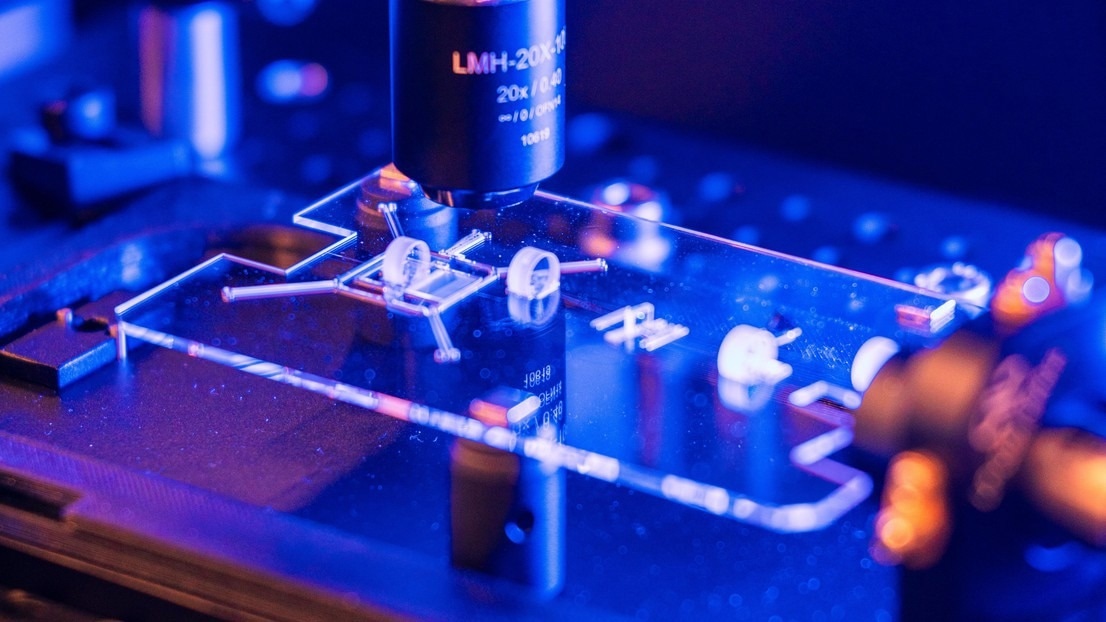Researchers from École polytechnique fédérale de Lausanne (EPFL) show that it is possible to make a femtosecond laser that fits in the palm of one’s hand with the help of a glass substrate.

Scientists from EPFL’s Galatea Laboratory make gigafemto lasers on a glass substrate. Image Credit: ©2023 EPFL/Jamani Caillet
Could a femtosecond laser composed entirely of glass be a reality? This intriguing question led Yves Bellouard, the leader of EPFL's Galatea Laboratory, on a journey after years of painstakingly aligning femtosecond lasers for laboratory experiments.
Situated at the intersection of optics, mechanics, and materials science, the Galatea laboratory considers femtosecond lasers a pivotal component of Bellouard’s research.
Femtosecond lasers generate incredibly brief and consistent bursts of laser light, finding utility in diverse applications such as laser eye surgery, non-linear microscopy, spectroscopy, laser material processing, and, more recently, sustainable data storage.
Typically, commercial femtosecond lasers are constructed by assembling optical components and their mounts on a substrate, typically optical breadboards, necessitating meticulous optical alignment.
We use femtosecond lasers for our research on the non-linear properties of materials and how materials can be modified in their volume. Going through the exercise of painful complex optical alignments makes you dream of simpler and more reliable ways to align complex optics.
Yves Bellouard, Head, Galatea Laboratory, École polytechnique fédérale de Lausanne
Bellouard and his team devised a solution involving the utilization of a commercial femtosecond laser to craft a compact femtosecond laser made from glass, no larger than a standard credit card, significantly reducing alignment challenges. The findings of their work have been documented in the Optica journal.
How to Make a Femtosecond Laser Out of Glass
The researchers started with a sheet of glass to make a femtosecond laser utilizing a glass substrate.
We want to make stable lasers, so we use glass because it has a lower thermal expansion than conventional substrates, it is a stable material and transparent for the laser light we use.
Yves Bellouard, Head, Galatea Laboratory, École polytechnique fédérale de Lausanne
Using a commercial femtosecond laser, the researchers carve intricate channels into the glass, allowing for precise placement of the critical components required for their laser system.
Despite achieving precision down to the micron level during fabrication, the grooves and components alone do not attain the necessary alignment for laser-quality performance. In simpler terms, the mirrors are not perfectly aligned, rendering their glass device non-functional as a laser at this stage.
The scientists also recognize, based on previous research, that they can locally manipulate the glass's expansion or contraction. They decided to leverage this technique to fine-tune the alignment of the mirrors.
Consequently, the initial etching process is specifically designed to accommodate one mirror within a groove equipped with micromechanical flexures. These flexures are engineered to adjust the mirror's position when exposed to femtosecond laser light.
This innovative approach transforms the commercial femtosecond laser into a tool for a second purpose: aligning the mirrors. Ultimately, this process results in the creation of a stable, small-scale femtosecond laser.
This approach to permanently align free-space optical components thanks to laser-matter interaction can be expanded to a broad variety of optical circuits, with extreme alignment resolutions, down to sub-nanometers.
Yves Bellouard, Head, Galatea Laboratory, École polytechnique fédérale de Lausanne
Applications and Beyond
The Galatea Lab’s ongoing research ventures will delve into the application of this technology within the realm of assembling quantum optical systems. This exploration aims to push the boundaries of what is currently achievable in terms of miniaturization and precision in alignment.
Presently, the alignment process remains under the supervision of a human operator and, with practice, can take several hours to accomplish. Despite its diminutive size, this laser boasts the capability to generate approximately one kilowatt of peak power and emits pulses lasting less than 200 femtoseconds—a duration scarcely sufficient for light to traverse a human hair.
The innovative femtosecond laser technology will be spun off into a new company called Cassio-P, with Antoine Delgoffe leading the venture at Galatea Lab. Delgoffe became involved in the project at a crucial juncture with the specific objective of transitioning the proof-of-concept into a viable commercial device for the future.
Bellouard added, “A femtosecond laser replicating itself, are we perhaps reaching the point of self-cloning manufactured devices?”
Journal Reference:
Delgoffe, A., et al. (2023) All-glass miniature GHz repetition rate femtosecond laser cavity. Optica. doi.org/10.1364/OPTICA.496503.